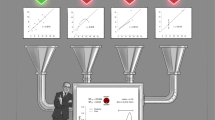Abstract
Schematic conflict occurs when evidence is interpreted in different ways (for example, by different people, who have learned to approach the given evidence with different schemata). Such conflicts are resolved either by weighting some schemata more heavily than others, or by finding common-ground inferences for several schemata, or by a combination of these two processes. Belief functions, interpreted as representations of evidence strength, provide a natural model for weighting schemata, and can be utilized in several distinct ways to compute common-ground inferences. In two examples, different computations seem to be required for reasonable common-ground inference. In the first, competing scientific theories produce distinct, logically independent inferences based on the same data. In this example, the simple product of the competing belief functions is a plausible evaluation of common ground. In the second example (sensitivity analysis), the conflict is among alternative statistical assumptions. Here, a product of belief functions will not do, but the upper envelope of normalized likelihood functions provides a reasonable definition of common ground. Different inference contexts thus seem to require different methods of conflict resolution. A class of such methods is described, and one characteristic property of this class is proved.
Similar content being viewed by others
References
Berres, M.: 1987, ‘On a Multiplication and a Theory of Integration for Belief and Plausibility Functions,’ Journal of Mathematical Analysis and Applications, 121, 487–505.
Briggs, L. K. and Krantz, D. H.: 1992, ‘Judging the Strength of Designated Evidence’, Journal of Behavioral Decision Making, 5, 77–106.
Coombs, C. H. and Avrunin, G. S.: 1988, The Structure of Conflict, Hillsdale, N. J.: Lawrence Erlbaum Associates.
Dempster, A.: 1967, ‘Upper and Lower Probabilities Induced by a Multivalued Mapping’, Annals of Mathematical Statistics, 38, 325–339.
Jeffrey, R. C.: 1965, The Logic of Decision, New York: McGraw-Hill.
Krantz, D. H. and Tversky, A.: 1971, ‘Conjoint-Measurement Analysis of Composition Rules in Psychology’, Psychological Review, 78, 151–169.
Shafer, G.: 1976, A Mathematical Theory of Evidence, Princeton: Princeton Univ. Press.
Shafer, G.: 1981a, ‘Constructive Decision Theory’, Synthese, 48, 1–60.
Shafer, G.: 1981b, ‘Two Theories of Probability’, in P. D. Asquith and I. Hacking (Eds.), PSA, 1978, Vol. 2. East Lansing, MI: Philosophy of Science Association.
Shafer, G.: 1982a, ‘Belief Functions and Parametric Models’, Journal of the Royal Statistical Society, Series B, 44, 322–339.
Shafer, G.: 1982b, ‘Lindley's Paradox’, Journal of the American Statistical Association, 77, 325–351 (with discussion and rejoinder).
Smets, P.: 1978, Un modele mathematico-statistique simulant le processus du diagnostique medical, These d'agregation, Free University of Brussels, Belgium.
Walley, P.: 1987, ‘Belief Function Representations of Statistical Evidence’, The Annals of Statistics, 15, 1439–1465.
Author information
Authors and Affiliations
Rights and permissions
About this article
Cite this article
Ray, B.K., Krantz, D.H. Foundations of the theory of evidence: Resolving conflict among schemata. Theor Decis 40, 215–234 (1996). https://doi.org/10.1007/BF00134208
Issue Date:
DOI: https://doi.org/10.1007/BF00134208




